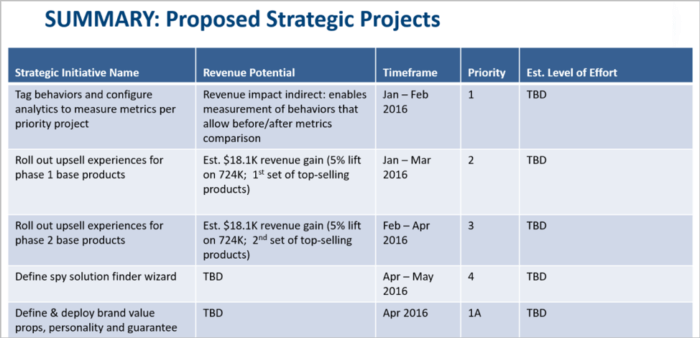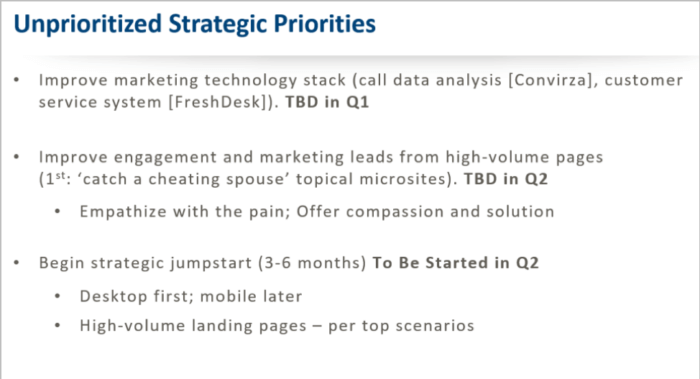You need a product roadmap so your team doesn’t get lost in the tactical weeds. Here’s what a great one looks like.
As Lewis Carroll famously said, ‘if you don’t know where you’re going, any road will get you there.’ When it comes to digital product planning, unless you want to risk wandering aimlessly, you’ll need a product roadmap. Besides keeping your team focused, a good product roadmap will help keep your work aligned with the expectations of your executive team. And it will show you’re keeping your eyes on the financial ball.
ere I share five essential traits of product roadmaps for owners of digital products, using examples from my experience that worked well. Take it, tweak it to make it your own, and use it consistently to keep your tactical work in line with your strategic goals.
1. Highlight your recent tactical results
Vision and strategies are great, but curious leaders of digital companies are often asking (or thinking), ‘What have you done for me [or the company] lately?’ So all of your product roadmaps should start by reiterating the recent progress you’ve made, both on tactical projects (which typically have four-to-eight-week timeframes) and strategic initiatives (which typically have three-to-six-month timeframes).
Here’s a ‘summary of last month’s initiatives’ excerpt from a product roadmap I prepared for a client of mine.

It’s simply a list of what we accomplished, and for what type of project (strategic or tactical). And it uses active verbs, not general project names or buzzwords. In other words, it reads more like a resume than a boring business presentation.
For each project, you should drill down into details for those who want them. In addition to sharing the purpose and status, be sure to include the expected outcomes of each effort. Ideally, these should include ‘hard’ outcomes like revenue gains or ROIs. But when these data aren’t available, you should at least share qualitative results.

‘No expected — and measurable — outcomes, no project.’ That should be your mantra. If it isn’t now, and you work in a data-driven organization, it probably soon will be.
2. Show your one-to-two-month tactical plan
Nearly every organization I work with loves Agile development. Yes, some do ‘real Agile’ and some just ‘talk the talk’. Regardless, your organization probably wants, even demands, that you push out product improvements fast. You need to reflect this expectation in your product roadmap documents.
So, be sure to include your near-term tactical plans in your roadmaps. And make sure you can push out improvements to your product at least every calendar month. This cadence will synch well with the 2-3 week timeframes of Agile development sprints.
Here’s a sample table showing the tactical projects planned for that same client.

Note that this shows projects rather than feature updates, which isn’t ideal. So that you can deploy product updates faster, and encounter fewer issues, you should break your projects down further, to the ‘micro-feature’ level:
- Tactical project one – product one – major feature one – micro-feature one
- Tactical project one – product one – major feature one – micro-feature two
- Tactical project one – product one – major feature one – micro-feature three
Discuss all candidate projects first with your product and executive teams, then come up with the best list of micro features. Then prioritization that list relative to other tactical projects. Maybe microfeature two on Tactical project two will add more value for your customers in the near term. If that’s the case, it should get a higher priority.
If you need some template starting points in your Agile organization, scrum.org provides several great examples of Agile product roadmaps.
3. Share your three-to-six-month strategic plan
The whole point of sharing a product roadmap, of course, is to share and track the progress you’re making on your strategic plans. So every roadmap you create should include your list of upcoming strategic projects.
For each strategic project, estimate it’s revenue potential (again, going back to that ‘No outcomes, no project’ mantra), timeframe and priority and level of effort. If two items have similar priorities, and one has a much lower level of effort, you can probably guess which one your executive team will choose.
Here’s a ‘strategic projects’ slide excerpt for that same client.

Note a couple of things here. The timeframes show a range of months, versus weeks, as done for tactical projects. It’s okay to be a bit vague here since these projects haven’t been launched yet. Just insert more specific timeframes when you later ‘project-ize’ these strategic efforts.
Also, note the last item related to brand value propositions. During a strategy call with the client that bumped up in priority (to ‘1A’). That’s because their executive team felt that new messaging, when deployed widely, would best increase their brand value in the minds of customers and prospects.
A couple of semantic notes:
- I’ve used ‘projects’ and ‘initiatives’ interchangeably. Often I see companies use the terms ‘tactical projects’ and ‘strategic initiatives’. Use whatever semantics your executive team prefers. When it comes to roadmaps, it’s essential to ‘speak the same language.’
- I’m talking about product roadmaps here, but I realize that, in the Agile development methodology, the Product Roadmap is more a prioritized queue of features. So be prepared to clarify the difference between the two if any confusion arises.

4. Expose your longer-term vision
Having a strong vision for your brand is important, but only if it drives the strategies that follow. Did Honda Motor Company just ‘instantly’ create its premium Acura automobile brand? No, that brand concept was part of their 30-year vision during a strategy meeting in Tokyo in the early 1980s. It’s reaping the financial rewards of that decision now, as Acuras (which shares a lot of mechanical parts with Hondas, and thus lower production costs), sell at much higher profit margins, as well as boost the company’s overall image.
My point here: Take some time to consider what your product — and more broadly, your brand — could be in the future. Then build some of this vision into your product roadmap. But, since technology changes so quickly these days, be sure to come up with a vision and strategies that can actually be executed within a few years.

5. Include transformative martech
Speaking of vision, if you ever want your product to make a ‘giant leap’ for mankind (or just customer-kind), you’ll need to introduce new technologies into your marketing technology stack from time to time. So constantly stay on the lookout for new tech that could truly transform your product. Websites like G2Crowd and Capterra are a good place to start your search.
If you get overwhelmed (easy to do!) engage the services of a martech advisor or strategist who can guide you through the vast sea of tech that’s out there.
Yes, these apps and systems require a considerably higher investment than you may be making in operational tools. But if you plan ahead for these investments, and can spread them out over a couple of years, they become manageable.
Finally, for the best results, inform your martech choices with customer research and insights. That way you’ll know your customers actually value the new tech you’re integrating into your product.
Time to revamp your roadmap
Creating a product roadmap for your digital product can be overwhelming, so maybe your organization doesn’t create them at all. But that would be a big mistake. Because, while your team may be able to crank out new features fast, you’ll lose sight of the bigger picture, and feature improvements that’ll transform both your product and your brand.
So take some time to consider, or completely revamp, how you prepare and share your product roadmap documents. Be sure to include some new tech and vision that will inspire your leadership to invest in cool and valuable features. And always share the financial outcomes you expect to get from adding each new feature or set of features. By doing so, you’ll surely get your executive team to lean in and listen.
